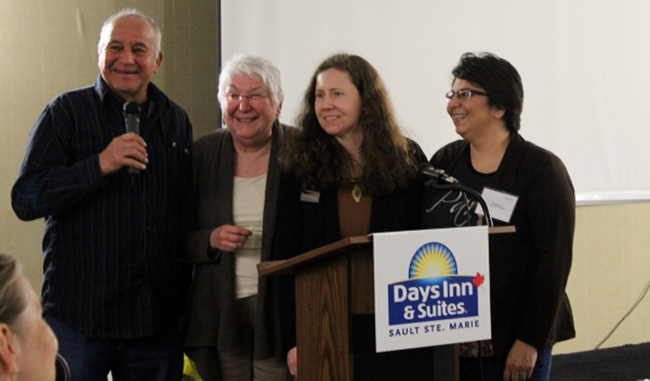Taking Care of our Land symposium a great starting point

By Karl Hele
SAULT STE. MARIE — Gdo akiiminaan ganawendanaan / Taking Care of Our Land Symposium organized by the Anishinaabe Initiative Division at Algoma University took place from May 4-6 . The symposium gathered together Anishinaabeg, Metis, and Non-Indigenous speakers and listeners to discuss the past, present, and future of gdo akiiminaan ganawendanaan. The symposium is a starting point into the exploration of research, culture, and tradition as well as best practises of land management, planning, and use for Aboriginal communities in Northern Ontario. The first day consisted of touring of both Batchewana (BFN) and Garden River First (GRFN) Nations where participants learned about the historical, contemporary, cultural, social, and political aspects of the communities and their land practices. Many spoke highly of Chief Sayers’ tour at Garden River.
The second day saw the first keynote speaker, Pamela Perrault, a doctoral student from Garden River, set the tone by offering a contextualization of Aboriginal land management and how it can be an expression of sovereignty. For Perrault, true Aboriginal land management only takes place when we have complete control of the decision making processes. Travis Jones, of the Environment Office for the Ontario Region Aboriginal Affairs and Northern Development (AAND) and member of GRFN spoke about programming funds at AAND, who could apply, and how to apply. He offered to assist individuals or communities seeking funds to help ensure a successful application. The second keynote speaker, Justice Stephen O’Neill, spoke of the need for reconciliation to move Canada forward. His remarks were framed within a judicial and political context that encapsulated Aboriginal sovereignty and rights. Linda Savory-Gordon, Missanabie First Nation, spoke to the need for inter-community cooperation to ensure rail service in the north as corporations are seeking to eliminate it in favour of transporting goods.
Also speaker, Chief Isadore Day, Wiindawtegowinini, Serpent River First Nation, and a panel consisting of Noel (Skip) Jones and Alice Corbiere, GRFN members, spoke to the notion of cooperation between First Nations and various levels of governments to achieve sustainable development. Chief Day spoke to the need for such cooperation, while Jones and Corbiere provided a concrete example. Specifically, Jones and Corbiere discussed their experiences negotiating and implementing the Garden River Highway and Lands deal signed in 1994. Interestingly, the cooperation and respect seen in 1994 obviously disappeared as evidenced in Chief Day’s call for its return. Jones and Corbiere’s personal experiences came through in the form of a story as they related the events and experiences of negotiations, frustrations, and successes.
The third and final day of the symposium had ten speakers and two workshops. Speakers included Anishinabekwe Rose Cameron, Algoma University, who spoke about the nuturance of Akii for her entire being; Raymond Owl, Elder, who discussed the need to prevent bad land management practises by listening to the knowledge of Elders and the land; Deborah McGregor, University of Toronto and member of Wiigwaskingaa First Nation, who addressed the importance of “Anishinaabe knowledge, traditions … [through] goverance, treaties and environmental justice”; Carly Dokis who spoke about the importance of bimaadiziwin in land, water, and land practises as it related to youth; Stephanie Seymour (GRFN member) and Mike Hosszu, Lakehead University, who discussed biofuels and their potential to unlock community development by reducing or eliminating reliance of imports of fossil fuels; Robert Rattle, Independent Scholar, who spoke at length about the importance of health impact assessments for Aboriginal communities; Mitchell Case, Metis student, who by mapping Metis movements in the nineteenth century showed the artificiality of government restrictions on their Aboriginal right to hunt and fish; Dean Sayer who delivered a powerful description of BFN’s assertions of sovereignty; and Karl Hele, Concordia University (GRFN member), who placed land management within the historical context of the Bawating borderlands.
A theme that readily emerged was the utility of GIS mapping. Stefanie Recollet, Wahnapitae First Nation, was the first to address GIS. She was followed by Cheryl Recollet, Wahnapitae First Nation, who offered a lunchtime keynote concerning her First Nation’s use of GIS. She spoke of the success of GIS in mapping historic, cultural, and contemporary use sites in the community, as well as the potential pitfalls of GIS. The biggest pitfall being once information is placed within a GIS database there is the potential for misuse and abuse of the knowledge – this was illustrated by people being concerned about losing their secret fishing holes. Cheryl rightly noted that Wahnapitae has a set of protocols about accessing who and in what context certain information can be accessed.
Overall the symposium was a great success. The audience readily queried the speakers and even offered their own experiences and knowledge in relation to land management. One resounding critique offered of several papers, one to which I agree, was the decided lack of contextualizing the presentations and discussions within the context of our treaties. Our treaties in many ways were about managing our lands to ensure a prosperous future for succeeding generations; gdo amiiminaan ganawendandaan was an excellent way to the start of discussion concerning land management as well as a great sharing of knowledge.


